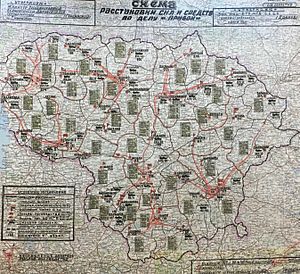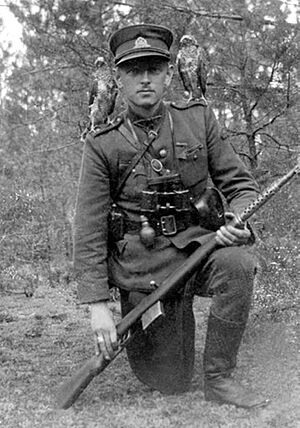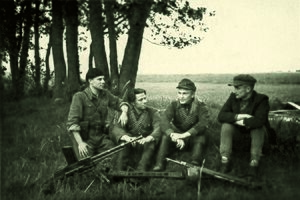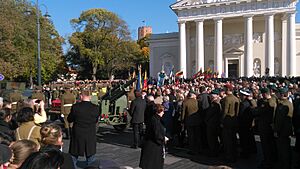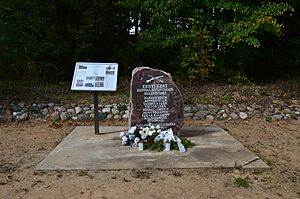Guerrilla war in the Baltic states facts for kids
Quick facts for kids Guerrilla war in the Baltic states |
|||||||
|---|---|---|---|---|---|---|---|
| Part of the occupation of the Baltic states and anti-communist insurgencies in Central and Eastern Europe | |||||||
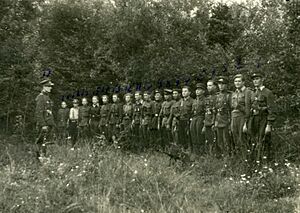 Lithuanian partisans from the Dainava military district |
|||||||
|
|||||||
| Belligerents | |||||||
| Strength | |||||||
| Unknown | ~50,000 | ||||||
| Casualties and losses | |||||||
|
~13,000 Soviet fatalities:
|
~20,000 Forest Brothers killed ~20,000 arrested in Lithuania |
||||||
| In Lithuania: at least 4,000 civilians who collaborated with the Soviets were killed by partisans; More than ~300,000 Lithuanians, Latvians and Estonians were exiled to Siberia. | |||||||
The guerrilla war in the Baltic states was a secret fight. It happened between 1944 and 1956. People from the Baltic states (Latvia, Lithuania, and Estonia) fought against the Soviet Union.
These fighters were also known as the "Forest Brothers". They were called this because they often hid and fought from the forests. They resisted the Soviet forces that took over their countries during and after World War II. Similar groups also fought against Soviet control in other parts of Eastern Europe.
Soviet forces, mainly the Red Army, first took over the Baltic states in 1940. After a short time under German control during World War II, the Soviets returned in 1944. As Soviet rule became harsher, thousands of people from the Baltics decided to fight back. They used the countryside as their base for this secret war.
It is thought that at least 50,000 fighters were involved. This includes about 10,000 in Estonia, 10,000 in Latvia, and 30,000 in Lithuania. Many other people supported them. The Forest Brothers kept fighting until 1956. By then, Soviet secret agents had entered their groups. This made it very hard to continue the armed struggle.
Contents
Why the Forest Brothers Fought
The name "Forest Brothers" was first used in the Baltic region around 1905. It referred to people who hid in forests to avoid trouble. In Lithuania, these fighters were called žaliukai (Green People) or miškiniai (Forest People).
Estonia, Latvia, and Lithuania became independent countries in 1918. This happened after the Russian Empire fell apart. People in these countries felt a strong sense of national pride. For Estonia and Latvia, it was their first time being independent since the 1200s. Lithuania had been a large, independent country before, but was taken over by Russia in 1795.
In 1940, the Soviet Union took over all three Baltic states. This was part of a secret agreement with Nazi Germany. Most Western countries did not agree with this takeover. When Germany later attacked the Soviet Union, Soviet troops left the Baltics. The area then came under German military control.
Germany did not give the Baltic states their independence back. However, promises from the Western Allies during the war gave hope. They hoped for a future where the Baltic states could be free again. Many people had already lived under Soviet and Nazi rule. They did not want another occupation after the war ended.
In Lithuania, the Germans created a local defense force in 1944. This force was meant to fight Soviet groups. But the Germans soon saw them as a threat. Many of these Lithuanian soldiers then went into hiding. They prepared to fight the Red Army as it returned.
In Estonia and Latvia, some soldiers from German forces also chose to stay and fight. They did not want to be captured by the Soviets. Many Estonian and Latvian soldiers, and some Germans, became Forest Brothers. They fought for years after the war ended. Some even escaped to other countries. They helped Allied intelligence support the Forest Brothers.
Many people joined the resistance because the Red Army tried to force them into service. Fewer than half of the people called up actually reported. This made the Soviets harass the families of those who disappeared. This pushed even more people to hide in the forests. Many soldiers also left the army, taking their weapons with them.
Early Resistance: The Summer War

When Germany invaded the Soviet Union in June 1941, Joseph Stalin told his forces to destroy everything as they retreated. About 10,000 Forest Brothers in Estonia formed local Home Guard groups. They attacked Soviet forces. They killed many soldiers and captured others.
A battle in Tartu, Estonia, lasted two weeks. It destroyed much of the city. The Forest Brothers drove the Soviets out of South Estonia by July 10. Soviet secret police killed many people in Tartu Prison as they left.
German forces entered Estonia in early July. They worked with the Forest Brothers and the Home Guard. Together, they pushed the Soviets out of Estonia. After the Soviets were gone, the German army disarmed all the Forest Brother groups.
In August 1941, the Estonian Home Guard was formed again. Its members were chosen from trusted friends. They had to promise they were not Communists. The Home Guard followed old Estonian army rules. Their jobs included defending borders, fighting spies, guarding important places, and helping the police. They also trained members and tried to keep patriotic feelings strong. By December 1941, the Home Guard had over 40,000 members.
The Guerrilla War Begins
From the late 1940s to the early 1950s, the Forest Brothers received help. Secret services from Britain, America, and Sweden sent supplies and officers. This help was important for the resistance. However, this support greatly decreased after Soviet spies found out about it. These spies shared information with the Soviets. This allowed the Soviet secret police to find and destroy many Forest Brother groups.
The fight between the Soviet forces and the Forest Brothers lasted over ten years. It cost at least 50,000 lives. It is believed that about 30,000 fighters were in Lithuania. There were between 10,000 and 15,000 in Latvia, and 10,000 in Estonia. Other reports suggest that Lithuanian losses were much higher than in Estonia or Latvia. This shows how strong the resistance was in Lithuania.
In Estonia

In Estonia, 14,000 to 15,000 men fought between 1944 and 1953. The Forest Brothers were most active near the borders and in certain counties. From November 1944 to November 1947, they carried out 773 attacks. They killed about 1,000 Soviet soldiers and their supporters.
At its strongest in 1947, the group controlled many villages and towns. They caused big problems for Soviet supply trucks, which needed armed guards. August Sabbe was one of the last Forest Brothers. Soviet agents found him in 1978. Instead of giving up, he jumped into a river and drowned. The KGB said he drowned trying to escape, but this was hard to believe. Another famous Forest Brother, Kalev Arro, hid for 20 years. He was killed in a fight with KGB agents in 1974.
Soviet officials often tried to find relatives of the Forest Brothers. They would question them harshly to get information.
In Latvia
In Latvia, people started getting ready for partisan actions during the German occupation. But the leaders of these groups were arrested by the Nazis. Later, new resistance groups formed. They included former soldiers and civilians. In September 1944, a group called the Latvian Central Council declared that Latvia should be independent again. They hoped to restore Latvia's freedom.
The number of active fighters in Latvia reached 10,000 to 15,000. The total number of people involved in the resistance might have been as high as 40,000. Over time, the partisans started using Soviet weapons instead of German ones. They carried out about 3,000 raids. They attacked military personnel, party officials, buildings, and weapon storage sites. Soviet reports say 1,562 Soviet people were killed and 560 wounded.
One story tells of Tālrīts Krastiņš. He was a soldier who joined a secret Nazi unit at the end of the war. His group hid in the forest. They avoided contact with local people. They robbed trucks for money. They also had a secret apartment in Riga for spying. At first, they killed low-level Communist officials. Later, they tried to kill the head of the Latvian Soviet government. Their attempts failed, and the group was caught in 1948.
The Latvian Forest Brothers were most active in border areas. They had connections with Estonian and Lithuanian Forest Brothers. Like in Estonia and Lithuania, Soviet secret police killed or infiltrated many groups. Soviet rule became stronger in the cities. Help from people in the countryside became harder to get. Special military units were sent to control the partisans. The last groups came out of the forest in 1957 and gave up.
In Lithuania
Among the three countries, the resistance was best organized in Lithuania. Guerrilla groups controlled large parts of the countryside until 1949. They had many weapons, including machine guns, mortars, and rifles. When they were not fighting the Red Army, they slowed down Soviet control. They did this by ambushing, destroying things, killing Communist officials, freeing captured fighters, and printing secret newspapers.
In July 1944, the Lithuanian Liberty Army (LLA) declared war against the Soviet occupation. They told all members to go into the forests and fight. The LLA had 10,000 members in mid-1944. The Soviets killed or arrested many LLA members by 1945. The LLA's founder was killed in 1944. This showed that a highly centralized resistance was too dependent on its top leaders. Later, remaining LLA members joined other Lithuanian partisan groups.
Another group, the Supreme Committee for the Liberation of Lithuania (VLIK), was formed in 1943. VLIK printed secret newspapers and encouraged resistance against the Nazis. After the Soviets returned, VLIK moved to the West. Its goal was to keep the world from recognizing Lithuania's occupation. It also shared information from behind the Iron Curtain.
Former soldiers and members of various Lithuanian groups became the basis of the partisans. Farmers, officials, students, and teachers also joined. Society and the Catholic church strongly supported the movement. By the end of 1945, about 30,000 armed people lived in the forests of Lithuania.
The partisans were well-armed. Between 1945 and 1951, Soviet forces took many weapons from them. The partisans got more weapons by killing Soviet secret police members or buying ammunition from Red Army soldiers. Every partisan had binoculars and a few grenades. They often saved one grenade to use on themselves if captured. This was to avoid harsh treatment and to protect their families.
To fight the guerrillas, the Soviets carried out a huge deportation in May 1948. This was called Operation Spring. About 40,000 to 50,000 people linked to the Forest Brothers were sent to Siberia.
Captured Lithuanian Forest Brothers often faced harsh treatment and quick executions. Their relatives were sent to Siberia. Soviet units, known as stribai (destroyers), used brutal methods against anti-Soviet farms and villages.
Juozas Lukša was one of the fighters who escaped to the West. He wrote a book about his experiences. He was killed after returning to Lithuania in 1951. Pranas Končius was one of the last Lithuanian resistance fighters. He was killed in 1965. He received a special award after his death. Benediktas Mikulis, another partisan, stayed hidden until 1971. He was arrested in the 1980s.
The End of the Resistance
By the early 1950s, Soviet forces had mostly wiped out the Forest Brother resistance. Soviet spies in the West and agents who joined the resistance helped them. Large Soviet operations in 1952 also helped end the fighting.
Many remaining Forest Brothers gave up their weapons after Joseph Stalin died in 1953. The Soviet authorities offered them a pardon. However, some isolated fights continued into the 1960s. The very last individual fighters stayed hidden until the 1980s. By then, the Baltic states were pushing for independence in peaceful ways.
What Happened Next
Many Forest Brothers hoped that the Cold War between the West and the Soviet Union would lead to a real war. They hoped this would free the Baltic states. But this never happened. Many surviving Forest Brothers felt bitter that Western countries did not fight the Soviet Union. When the Soviets crushed the Hungarian Revolution of 1956, and the West did not intervene, organized resistance in the Baltics weakened even more.
The Soviet Union did not officially document this conflict. They treated the Baltic fighters as common criminals. Because of this, some people call it an unknown or forgotten war. Talking about the resistance was not allowed under Soviet rule. Writings by Baltic people living abroad were often ignored. Research started in Estonia in the late 1980s helped open the door for more study.
In 1999, the Lithuanian parliament recognized a declaration of independence. This declaration was made by resistance groups in 1949. It stated that an organized armed resistance took place in Lithuania from 1944 to 1953. Its goal was to free Lithuania. It fought against one of the World War II aggressors. The Council of the Movement of the Struggle for Freedom of Lithuania was the main political and military group. It was the only legal authority in occupied Lithuania.
In Latvia and Lithuania, Forest Brothers veterans now receive a small pension. In Lithuania, the third Sunday in May is known as Partisans' Day. In 2005, there were about 350 surviving Forest Brothers in Lithuania.
In 2001, U.S. Senator John McCain spoke in Tallinn. He recognized the Estonian Forest Brothers and their efforts.
The Last Forest Brother
The last known Forest Brother was Jānis Pīnups. He did not come out of hiding until 1995. He had left the Red Army in 1944. He was knocked out and left for dead during a battle. He decided to go home. He then hid in the nearby forest. He was afraid his family would be sent away if his leaving the army was found out.
About 25 years after he went into hiding, he needed medical help. After that, he started to act more freely. Still, only his siblings and closest neighbors knew who he was. Even the rest of his family did not know he was alive until he came out of hiding.
See also
- Anti-Soviet partisans
- Battle of Määritsa
- Occupation of the Baltic states


